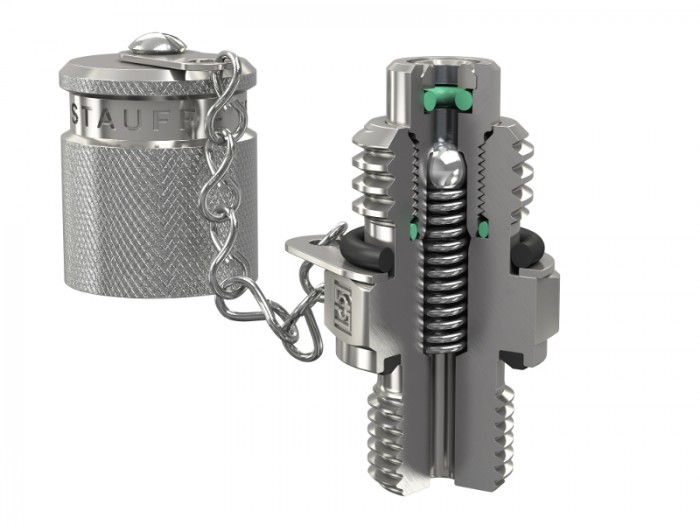Stauff expands its Test range with new Test couplings

Cross section of a male stud test coupling SMK with integrated ball valve from the Stauff Test 20 range
Photo by Walter Stauffenberg GmbH & Co. KG
Remarkably easy and safe connection of measuring and display devices
In addition to flow, pressure is without doubt the most relevant parameter and measuring factor in hydraulics. Measuring system pressure is therefore the most important and most frequently used method for monitoring, controlling and preventive service and maintenance of hydraulically operated machines and systems. It is the prerequisite for their economical operation.
Test couplings from the Stauff Test range are already planned during the design phase of a machine and installed in suitable positions in the hydraulic system at the factory. They allow machine operators and maintenance personnel to easily and safely connect analogue and digital measuring and display devices for the temporary or continuous testing of system pressure and other factors. If required, they also allow venting of the system as well as collecting representative fluid samples, e.g. for analysing the degree of contamination of the fluid. This type of connection requires no tools and can also be carried out during operation under full system pressure up to 630 bar (depending on the type of coupling).
The check valve (ball or poppet valve) integrated into the test coupling opens only after connection of the hydraulic tester with suitable adapters or hoses. This guarantees safe sealing of the connection without leakages and danger of fluids escaping from the system.
Stauff test couplings are not crimped after insertion of the internal valve components and seals but rather closed with a threaded nipple in a fully automated process. Not only does this design contribute to maximum precision and process reliability in production, it also secures the proper functioning of the couplings. The vibration protection, which prevents a self-acting detachment of the protective metal cap through vibrations in the system, is another competitive advantage.
For the finishing of the test coupling range in carbon steel, Stauff relies on the zinc/nickel surface coating which has proven successful for many years. It provides more than 720 hours of resistance against red rust/base metal corrosion in the salt spray chamber in line with DIN EN ISO 9227. The chromium(VI)-free coating therefore exceeds the highest requirements with regard to resistance and durability and also complies with the valid ELV, REACH and RoHS guidelines.
Versions in stainless steel V2A and V4A are generally available from stock. Alternative materials and surfaces are available on request.
For more information, please visit http://www.stauff.com.
News Categories
- » NEWS HOME
- » Automation & Robotics
- » Industry 4.0
- » Material Handling
- » Sensors
- » Quality & Testing
- » Machine Vision
- » Laser & Optics
- » Metalworking
- » Motion Control & Drives
- » Hydraulics & Pneumatics
- » Process Industry
- » Renewable Energy
- » Agriculture
- » Home & Office Furniture
- » Environmental Tech


